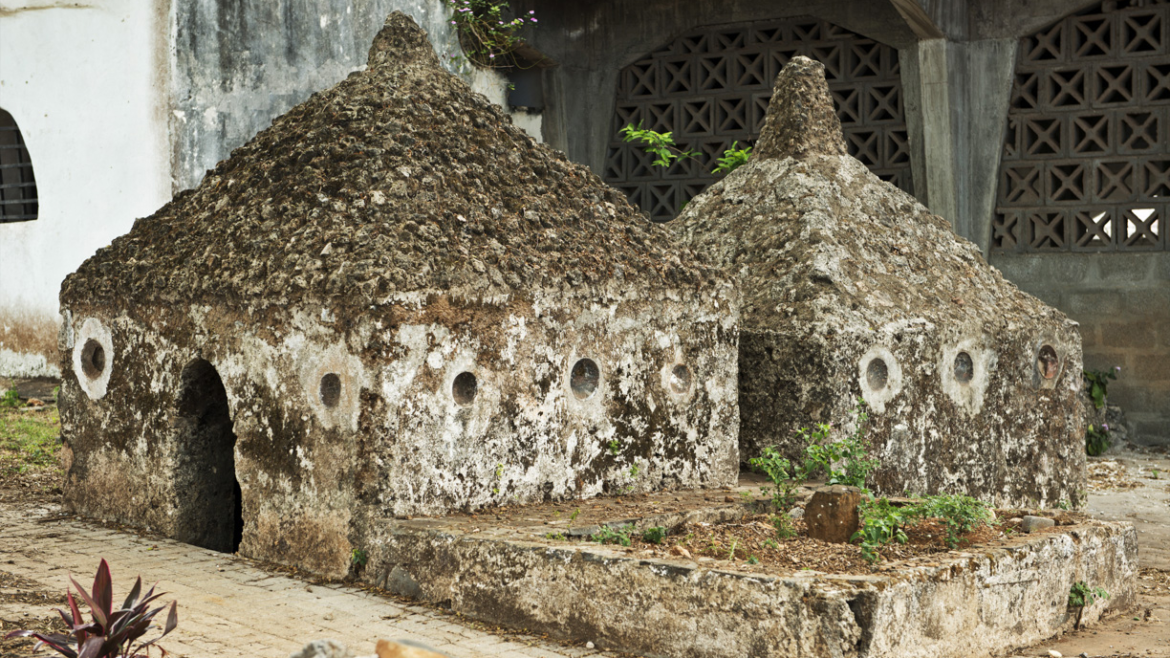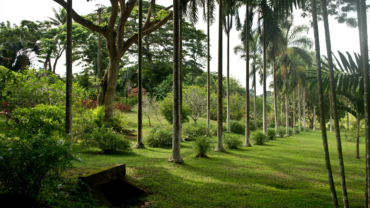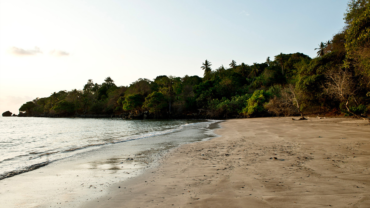Mayotte - Magic of Traditions
Anchored in its regional environment, the island has undergone African, Eastern, Indian, European and Malagasy influences.
Mahorese gastronomy
Rich and varied flavors
Satisfying your taste buds in Mayotte is not complicated, you still have to know where and especially what to eat. Obviously, the mama brochetti experience (women who make kebabs) is often a recommended step. But if you are not a fan of meat skewers or chicken wings (grilled mabawa), there are many solutions available to you.
The dishes that are often served in restaurants are mataba or feliki mhogo (cassava leaves crushed and cooked in coconut milk) or romazava (meat or fish broth accompanied by mafana brèdes). These are served with white rice and for those who like dishes spiced with pepper, commonly called poutou.
The pilao (with beef or chicken) is also a must. But to think outside the box, you can ask to taste traditional dishes that
are usually made on special occasions. This is particularly the case of trovi ya nadzi (bananas with coconut, topped with meat or fish), mtsolola (stew of bananas, breadfruit and cassava, with fish or meat), mhogo wa piki (dried cassava balls cooked in coconut milk) or ubu wa ndrimu (lemony rice soup with seafood). These rich dishes are largely satiating.
In fact, there are few Mahorais desserts. Among these are in particular Toubtoub (cassava dumplings dried in coconut) or fenyenyetsi (rice cake cooked in coconut milk). But nothing beats the succulent seasonal fruits such as mangoes, pineapples, papayas (also excellent in salty salads when they are green), cinnamon apples or even guavas.
Immersion in the history of Mayotte
From the 13th century, the island came under the influence of clans from the Swahili and South Arabian coast. Then in the 16th century, Shirazian migrants established sultanates on the island. A large division will reign over the Comoros archipelago. The era of the “battling sultans” arrived, followed by the Malagasy invasions.
Adriantsouli, former King Sakalavian converted to Islam, who proclaimed himself sultant of the island, cedes the latter to France on April 25, 1841.
The Art of Bandrélé Salt
Go and meet the “mama shingo”… They will explain each step of the production of this totally natural salt with a unique taste: the picking up, directly on the soil of the silt, loaded with salt after the seafood, the making of the mounds. of silt using a coconut cut in half, the filtration which consists of putting the silt in basins found clogged with a bag of rice which serves as a filter and to sprinkle it with water of sea to obtain a heated liquid in large rectangular tanks, regularly stirred.
A liquid which will therefore evaporate little by little and will only leave in the tank a salt of an astonishing whiteness! This will then be packaged in small bags offered for sale in the pretty museum house, managed by the ANPCBA association. You will also find, on clear and precise panels, the detailed explanation of this whole process.
The M’sindzano
By rubbing a piece of sandalwood on a coral stone, the dark grain of this ‘mask table’ turns the wood into powder.
The women add a few drops of water to it and then apply the creamy white paste obtained on the face, either in the form of a mask or by drawing ornamental patterns which repeat themselves.
This traditional makeup provides a natural screen against the sun and erases impurities from the skin. Giving women an exotic charm, msindzano, which can be prepared with other powders such as saffron or turmeric, is a natural scent of seduction.
Kibushi and Shimaoré languages
In addition to French, two languages are spoken in Mayotte: shimaoré (chimaoré) and kibushi.
Shimaoré, a language of Swahili origin, is spoken by the majority of the population. Kibushi is of Malagasy origin, especially from northwestern Madagascar. These two languages interfere and therefore have certain words in common. Shimaoré and kibushi are mainly oral languages, but recently, work is underway to fix them. What writings, what letters used? So many questions that the Shimé association is working to resolve.
The Mahorese languages have Arabic influences linked in particular to the strong influence of the practice of Islam and the attendance of Koranic schools. But at the present time, it is French that influences its languages, to such an extent that we speak of the process of “creolization” especially among the new generation.The phenomenon is even more important in children under five, most of whom speak only French. The kibushiphones villages are spread geographically from the south and north west of Mayotte as well as in certain districts of Mamoudzou and Pamandzi.
The shimaore remains however dominant on the whole island.
Traditional outfits
The traditional Mahoraises outfit is the salouva, made up of three pieces: the salouva itself, a large strip of fabric sewn and tied at the chest, a t-shirt often close to the body also called a “body”, and a kishali, shawl covering the hair or placed on the shoulder.
There are several types of salouva, worn depending on the occasion: embroidery salouva, which can be very expensive, is preferred for important ceremonies. While megalin and nambawane are more common.
With the mixing of population, the outfits evolve and the young generation tends to get rid of the salouva and only casually wear a shawl on their hair or shoulders. The chiromani from Anjouan,
made of a single piece of fabric, in which the woman drapes herself, is also very common and many brides prefer the Indian sari.
M’sinzano (paste made from sandalwood) is very common for sun protection. It can be worn as a full face mask or as delicate decorations to highlight the fine features of the face. For men, if daily attire remains in Western fashion, the kandzu (embroidered boubou) can be worn for all religious occasions, and in particular with the djoho (velvet coat embroidered with gold thread) at weddings.
The kofia – small hat – is also worn very commonly, on a daily basis.
The island of Mayotte and its influences
Anchored in its regional environment, the island has undergone African, Eastern, Indian, European and Malagasy influences.
Mayotte is at the center of the Mozambique Channel; by virtue of its history, the majority of the population is of muslim faith, by its political choices, it is french. Most traditions thus combine Muslim customs and ancestral animist practices, such as rumbus ceremonies, where spirits (jinn or trumba in kibushi) are invoked through fundis, often through alcohol and against a background of very rhythmic music. The fabrication of gris-gris and its consequences – positive or negative – is still widely practiced.
On the contrary, the month of Ramadan and religious festivals such as Eid el Fitr, Eid el Kebir and Maoulida are sacred. Mayotte is the perfect example that Islam and the Republic are totally compatible. July 14, a national holiday, is an opportunity for the population to greet the symbols of the Republic during the annual parade. Similarly, religious notables are systematically associated with national commemorative ceremonies.
The population lives in harmony on a small territory where Mahorais, Indians, Africans, Malagasy and metropolitan people live together. The mixtures and interbreeding occur naturally and the practice of languages is a perfect example of influences: Shimaoré, a language from Swahili, has integrated terms from French, Arabic, and even from English and French. ‘Italian.
The cohabitation of shimaoré and kibushi is a good illustration of the close links that exist between Madagascar and Mayotte. If Western influence is omnipresent, several local sociologists and linguists are carrying out identity research and seeking to establish the bases of “mahority”, between religion, traditions and ethnic mixing.
Mayotte, a tolerant Islam omnipresent in everyday life
In Mayotte, the Muslim religion is present in all aspects of life.
The first traces of the Islamization of the island of Mayotte date back to the 9th century AD and today the majority of the island’s population practice it. Thus, before sunrise (between 4.30 a.m. and 5 a.m.), men go to mosques (most homes are within a 10-minute walk of a place of worship) to perform the first of five prayers that punctuate the day. Children go to madrassas (Koranic schools), before or after secular republican school to receive religious education.
In Mayotte, Islam is not just a religious practice, it is a way of life.
All events, large and small, are accompanied by religious practices. One invocation is never too much to win the favor of Allah, whether you are going on a trip, inaugurating your home, organizing a wedding, taking a professional competition or simply leaving your home. for the day.
So don’t be surprised to hear the Mahorais punctuate their sentences with the expression “Inch’Allah” or its Mahorese equivalent “Neka mungu a vendze” (God willing)!
To play with the evil eye, some children wear around their neck a “hirizi”, a talisman in which are locked verses from the Koran and many houses have above their front door folded sheets of paper on which there are prayers of protection.
But as Mayotte is a land of mixed race, Islam in Mayotte coexists perfectly with other religious practices. It even happens to mix with some of them. This is particularly the case with certain disenchantment ceremonies such as the “roumbou”, of Malagasy origin or the “ziara” (places of commemoration of ancestors, a practice of animist origin).
This pervasive dimension of Islam is further exacerbated during the holy month of Ramadan.
Everything is organized so that believers can live this festive month as well as possible. Shops and administrations are shifting their closing hours to give families time to prepare foutari (fast breaking meal) . Secular activities such as concerts or beach walks are put on hold and the manifestation of faith is materialized by the resumption of aloud the verses of the Koran during the night prayer of “tarawihi”.
A culture rich in tradition
In Mayotte, the Muslim religion is present in all aspects of life. The first traces of the Islamization of the island date back to the 9th century AD and today the majority of the island’s population practice it.
Thus, before sunrise (between 4.30 a.m. and 5 a.m.), men go to mosques (most homes are within a 10-minute walk of a place of worship) to perform the first of five prayers that punctuate the day.
Children go to madrassas (Koranic schools), before or after secular republican school to receive religious education. In Mayotte, Islam is not just a religious practice, it is a way of life. All events, large and small, are accompanied by religious practices.
One invocation is never too much to win the favor of Allah, whether you are going on a trip, inaugurating your home, organizing a
wedding, taking a professional competition or simply leaving your home. for the day. So don’t be surprised to hear the Mahorais punctuate their sentences with the expression “Inch’Allah” or its Mahorese equivalent “Neka mungu a vendze” (God willing)!
To play with the evil eye, some children wear around their neck a “hirizi”, a talisman in which are locked verses from the Koran and many houses have above their front door folded sheets of paper on which there are prayers of protection.
But as Mayotte is a land of mixed race, Islam in Mayotte coexists perfectly with other religious practices. It even happens to mix with some of them. This is particularly the case with certain disenchantment ceremonies such as the “roumbou”, of Malagasy origin or the “ziara” (places of commemoration of ancestors, a practice of animist origin).
This pervasive dimension of Islam is further exacerbated during the holy month of Ramadan. Everything is organized so that believers can live this festive month as well as possible. Shops and administrations are shifting their closing hours to give families time to prepare foutari (fast breaking meal).
Secular activities such as concerts or beach walks are put on hold and the manifestation of faith is materialized by the resumption of aloud verses from the Koran during the night prayer of the “tarawihi”.





